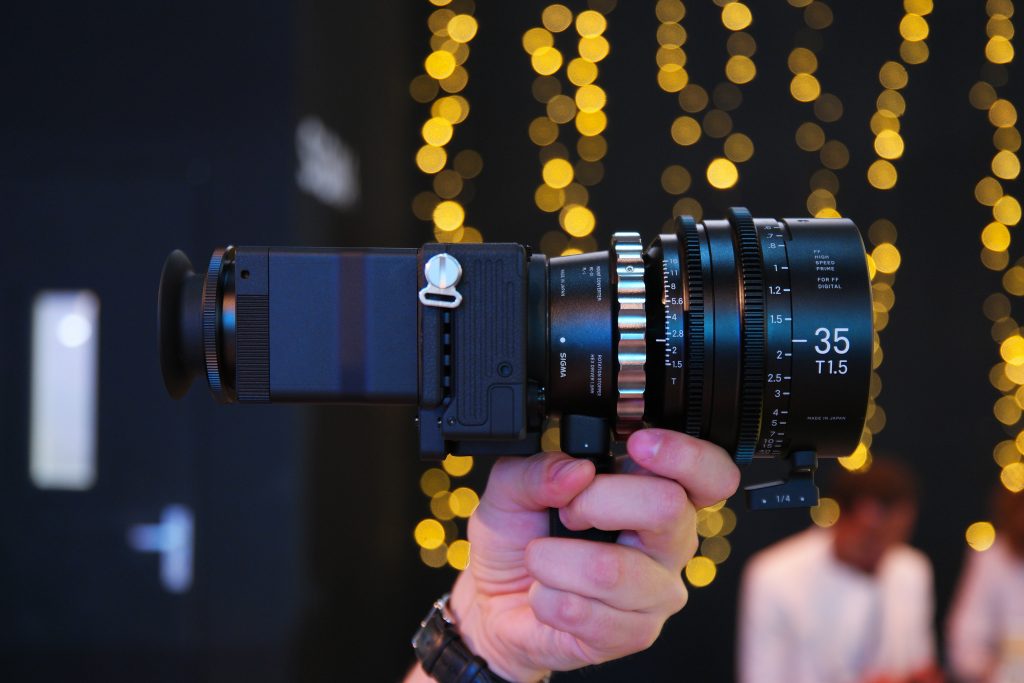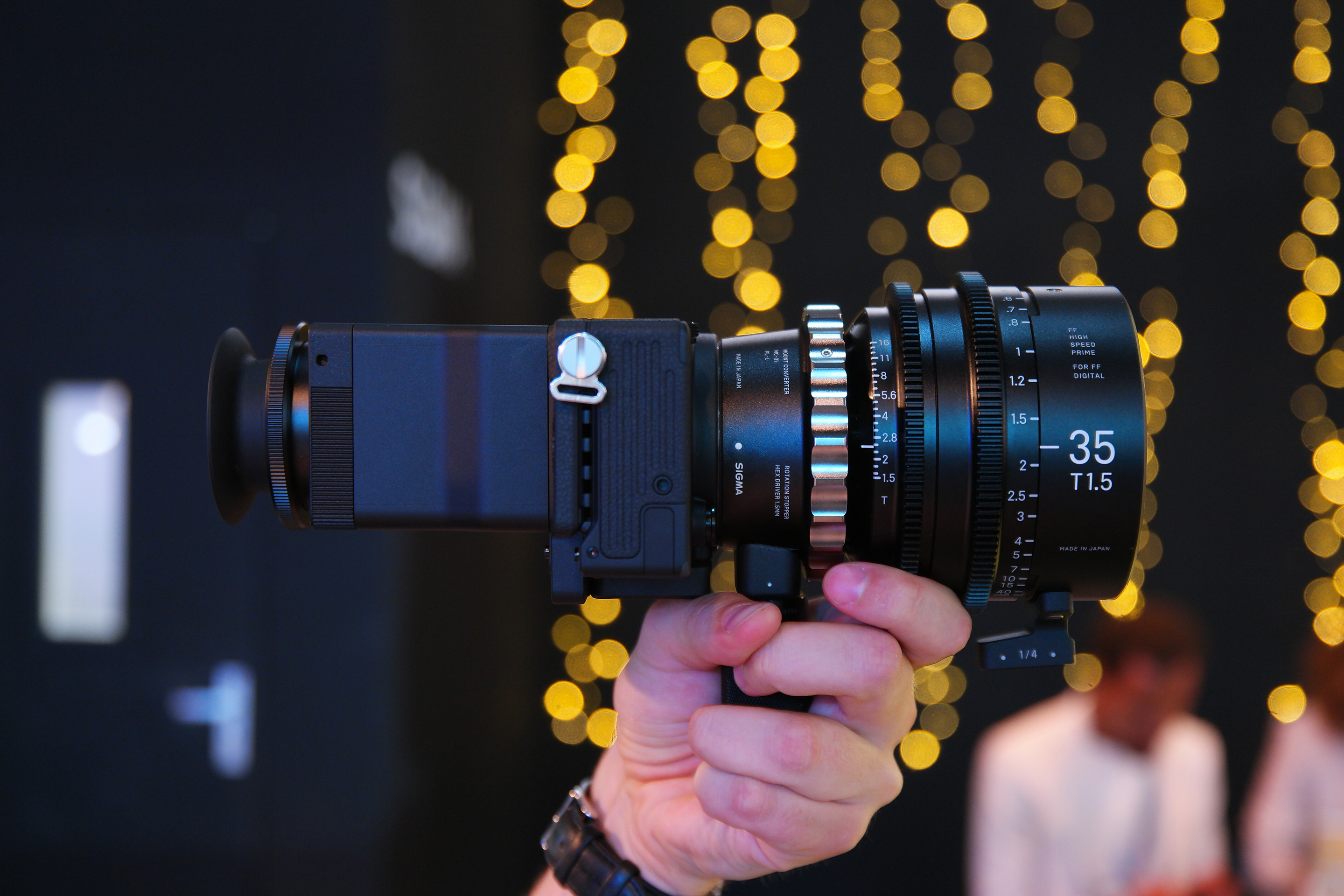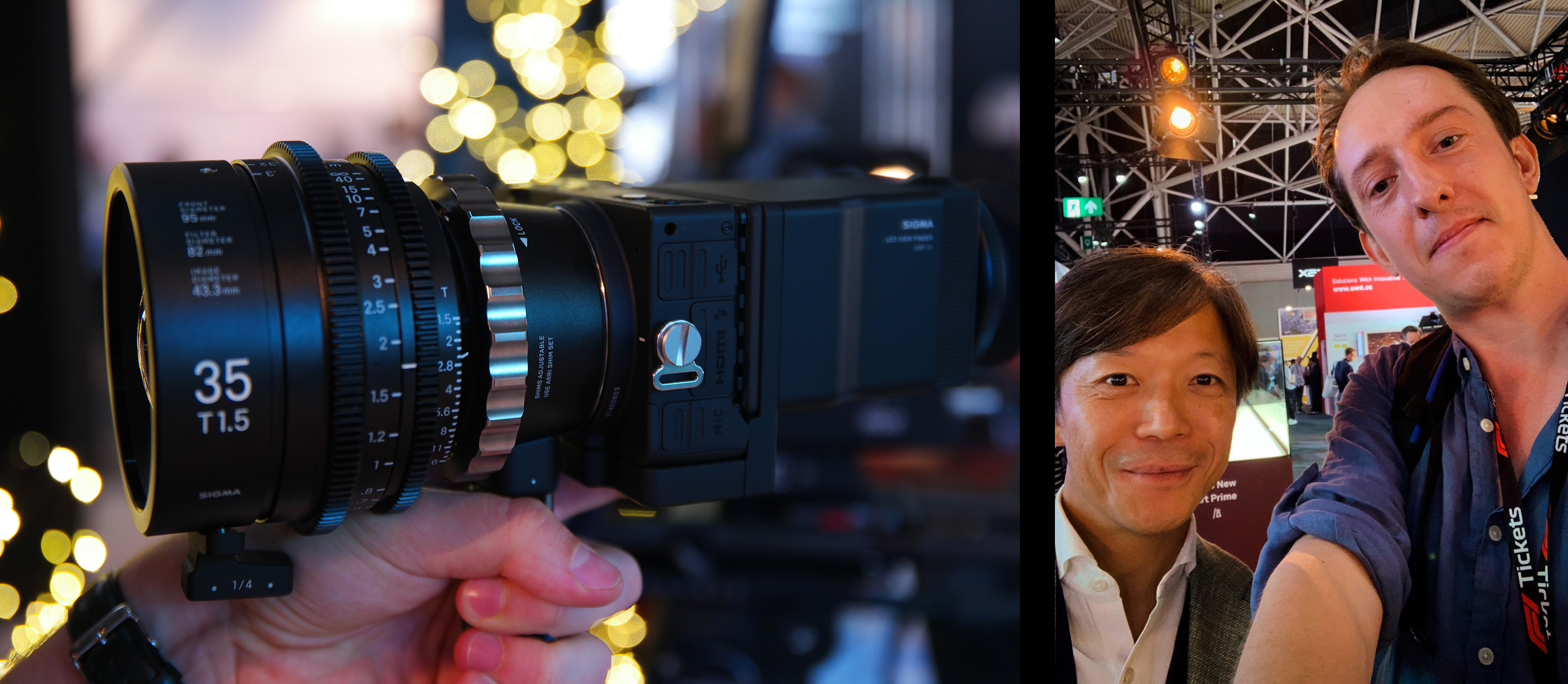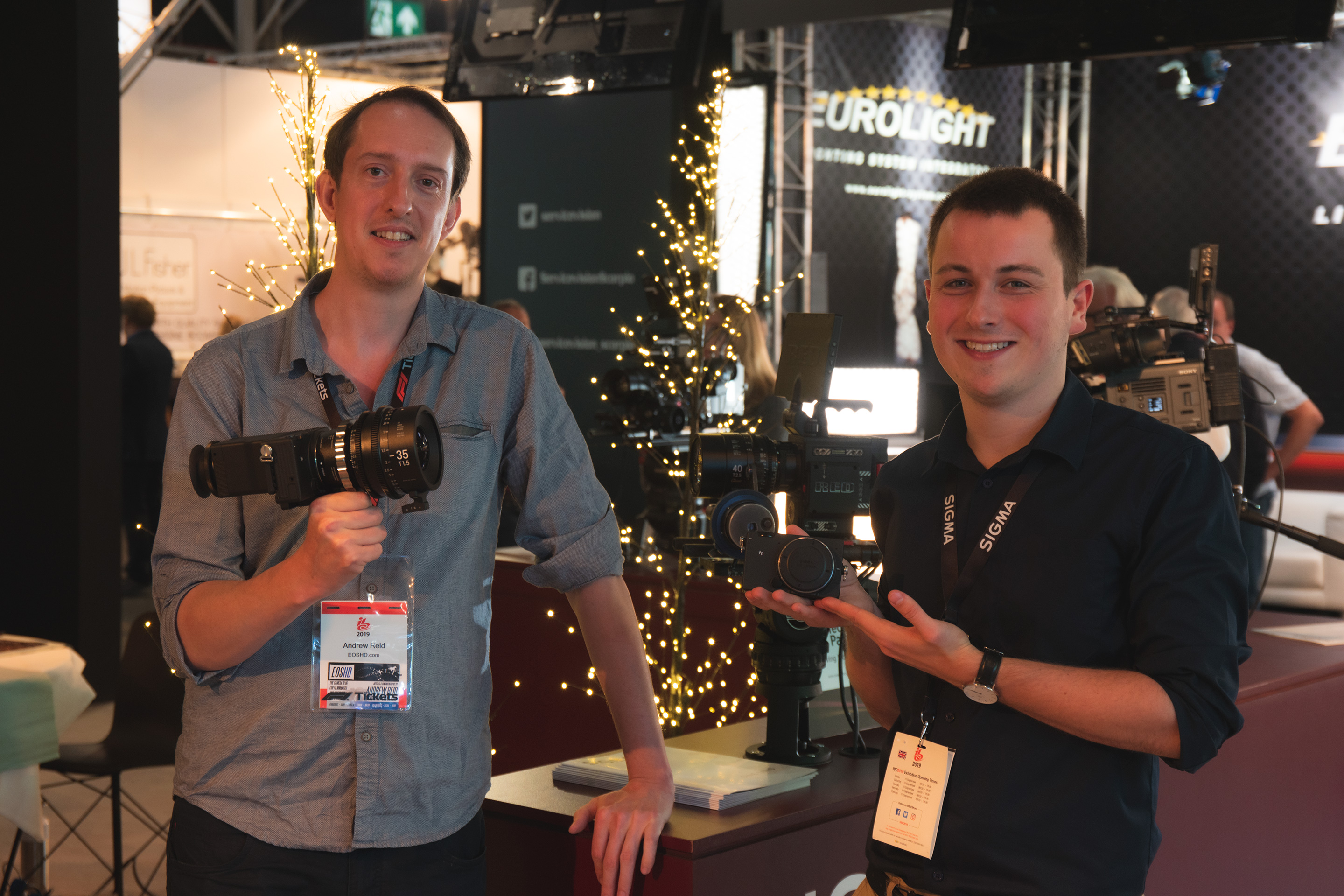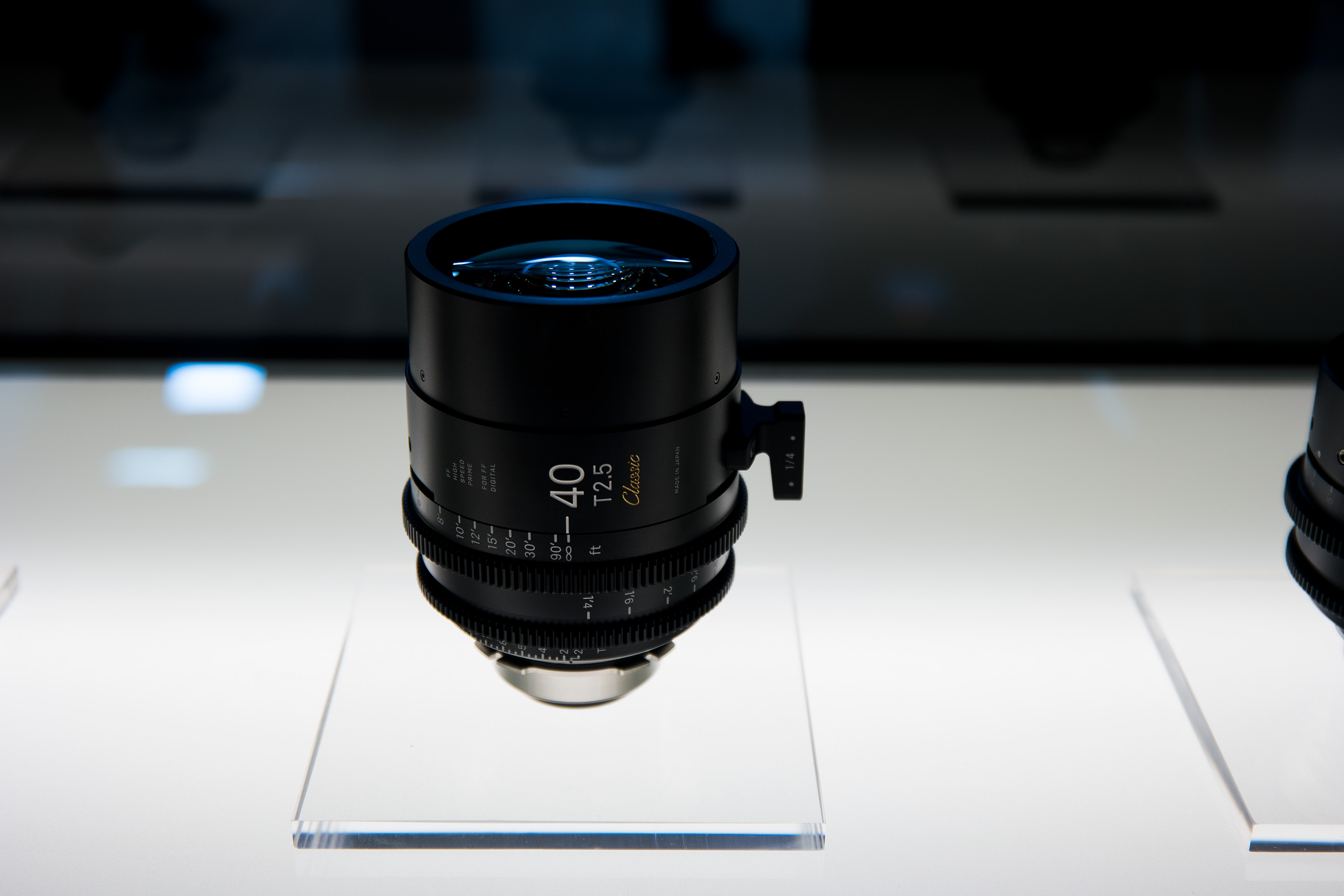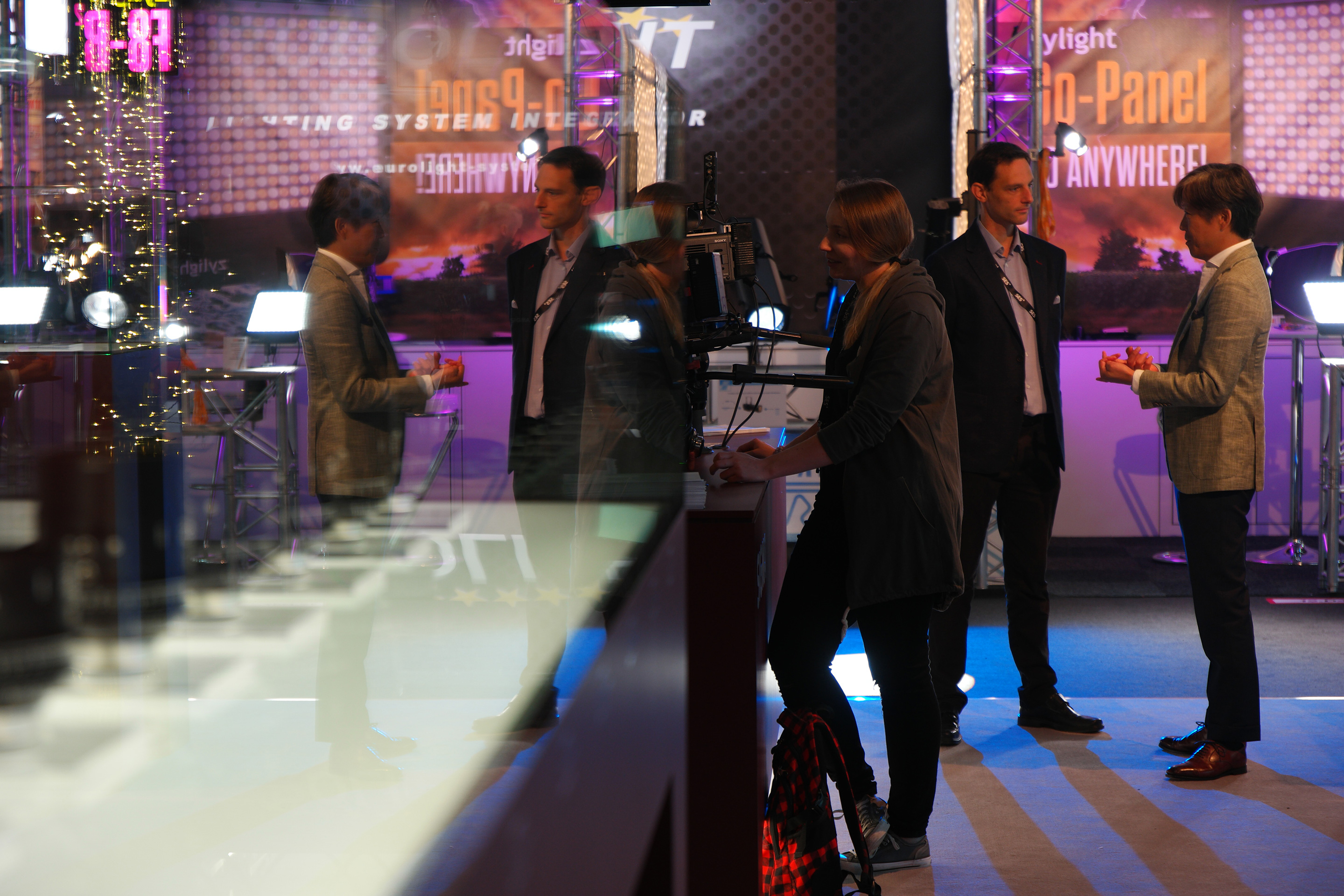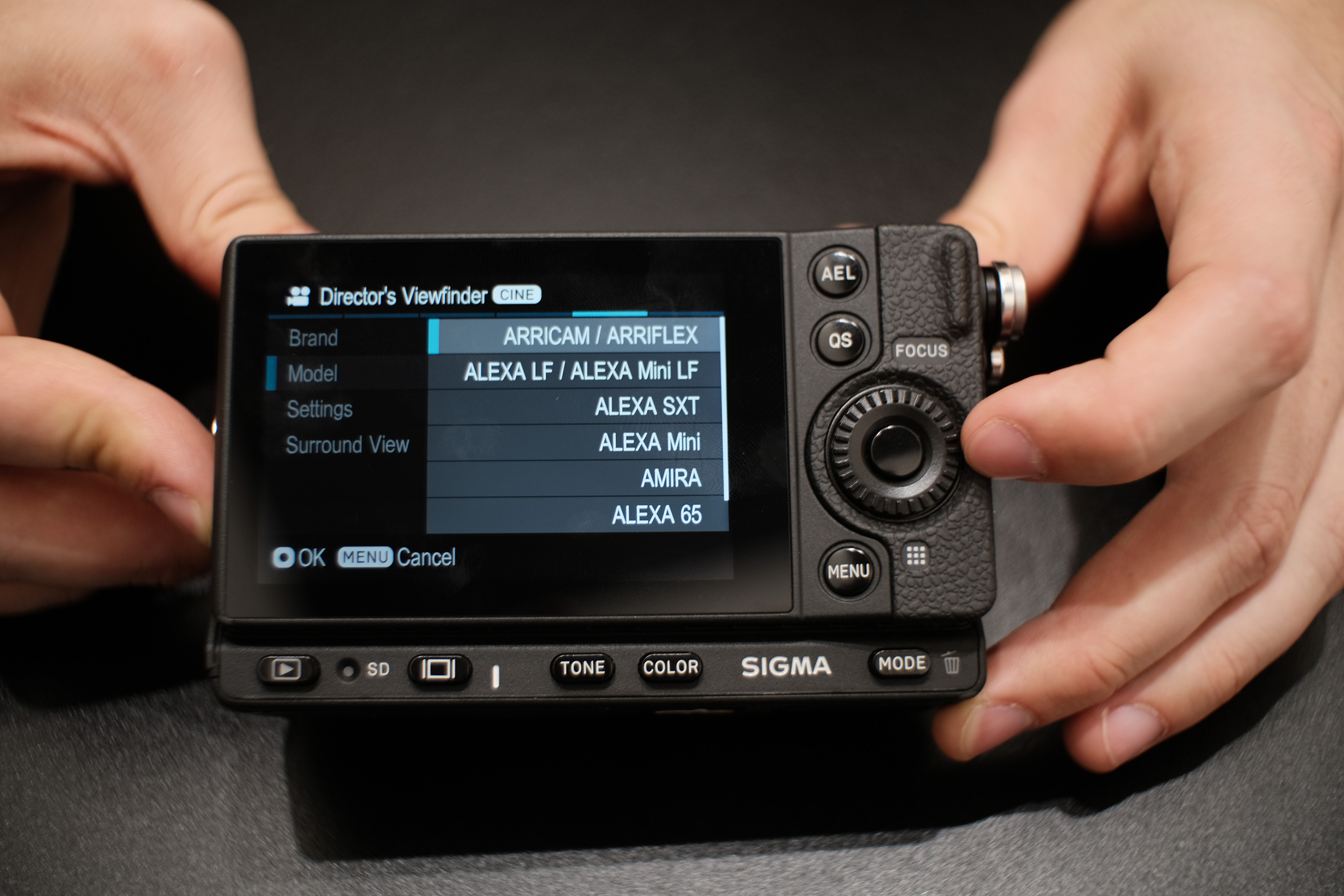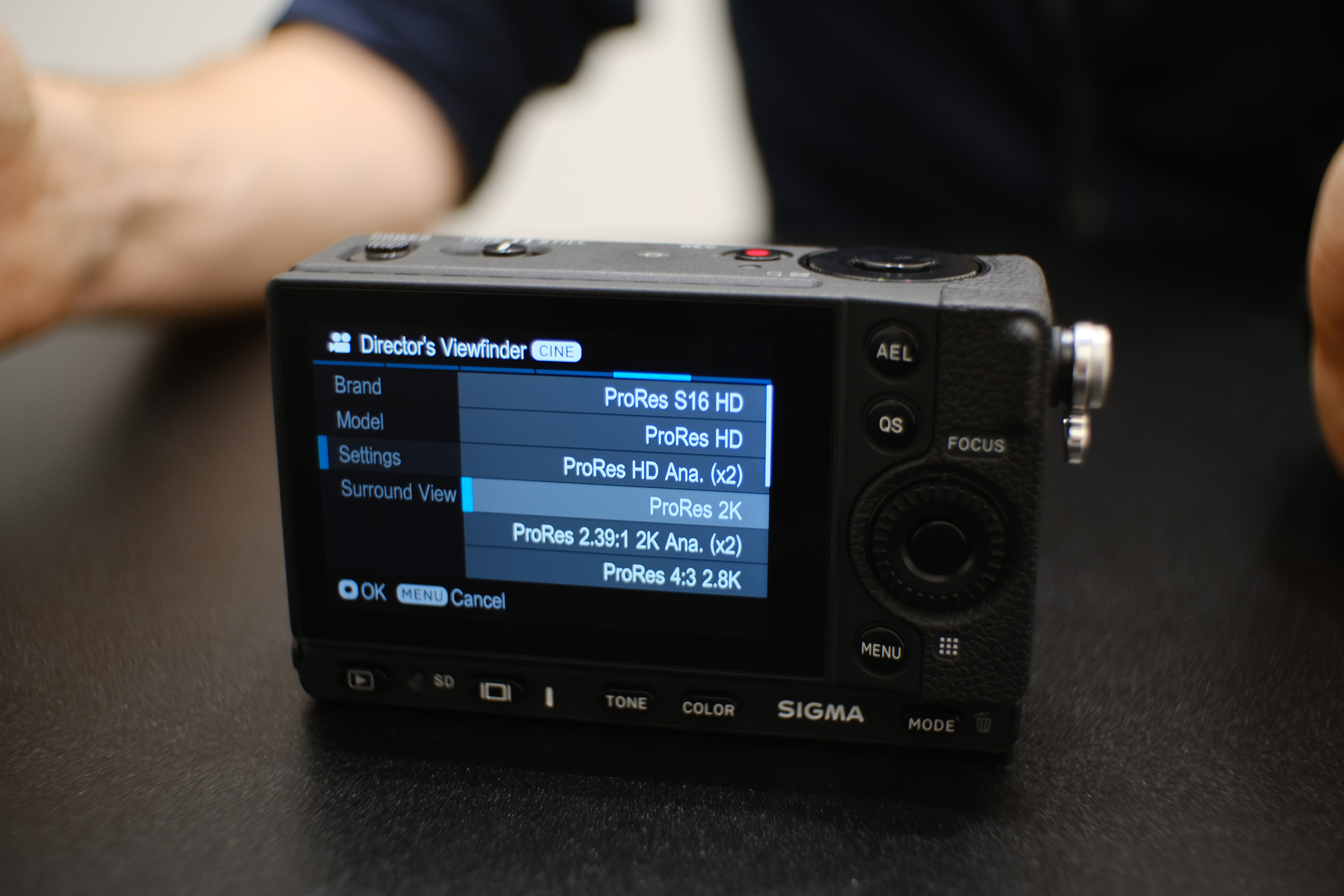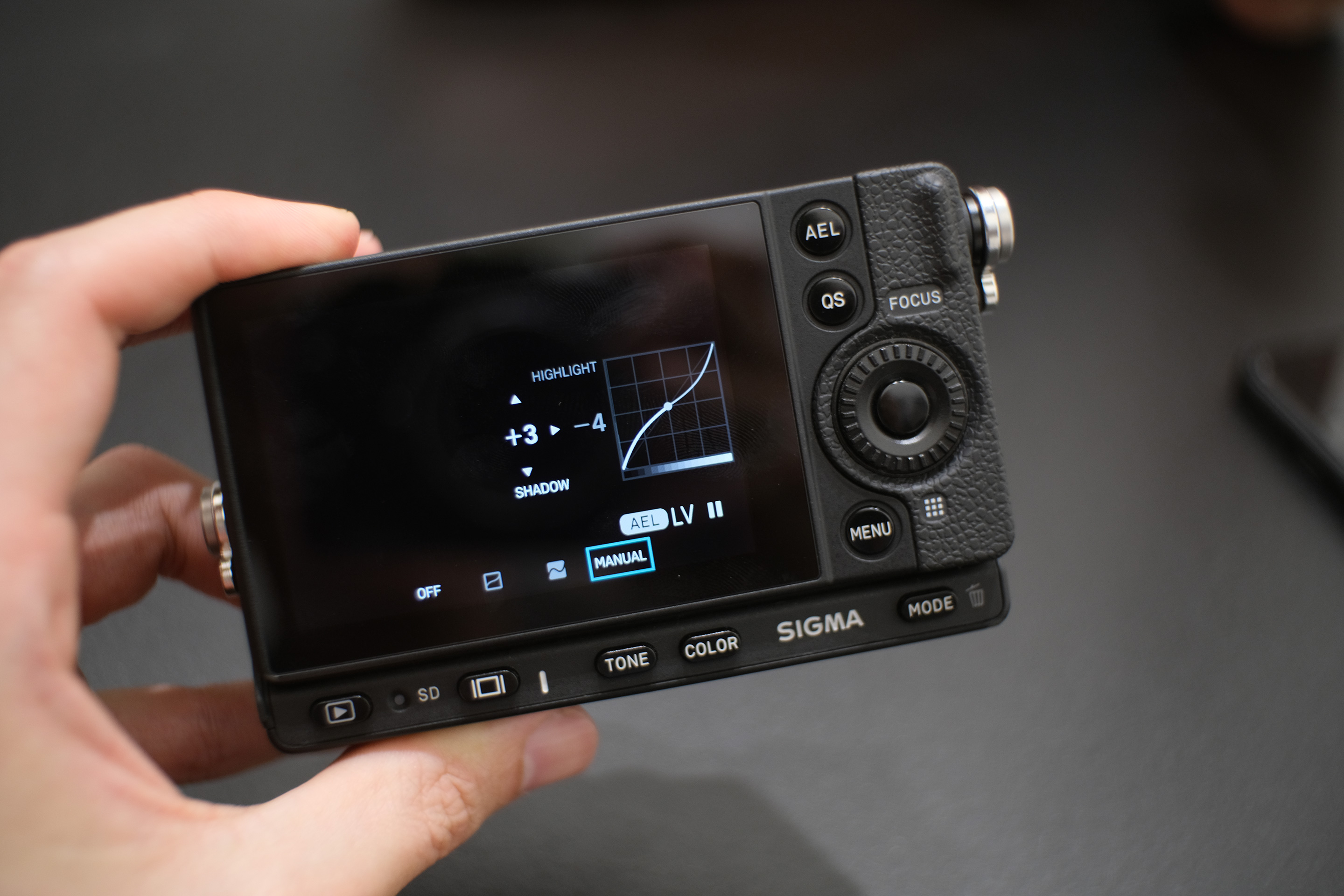
There were two highlights of IBC 2019 for me. The Sigma Fp, and the Z-CAM range. From the ground-up the Sigma Fp seems to be aimed at us, at artists. A small and incredibly light camera that hits the big full frame notes, some of the niche features like the digital director’s viewfinder are unheard of in consumer full frame cameras from major manufacturers.
This is clever and will get the camera a lot of use by top-flight talent. Most exciting for me is the focus on the video recording features – which are big step for Sigma and indeed push the boundaries of what we expect from a “prosumer” camera.
- Cinema DNG RAW 4K 12bit to USB C SSD media
- Internal 1080p 12bit internal RAW Cinema DNG uncompressed
- Internal 4K RAW uncompressed (bit-depth drops to 8bit at the moment)
Interestingly I also bumped into Sigma CEO Kazuto Yamaki at the show and had some small-talk. I had my venerable Samsung NX1 with me, and he remarked that the product manager for the NX1 went to work for Sigma’s camera team on the Fp! So they are in good hands as this camera was genuinely ground-breaking and ergonomic.
As this is Sigma’s first camera to shoot 4K, and the first ever Fp camera in the range, much can be added as the camera matures through subsequent generations and firmware updates. It’s a good start though, with a comprehensive and well prioritised feature-set. In the brochure at IBC the Fp was listed as shooting 4K 10bit RAW internal to UHS-II SDXC card but this has since dropped to 8bit to get the data-rate under what the card can sustain.
This is real RAW and it’s uncompressed. 8bit and RAW seem like oxymorons but how many other full frame cameras shoot Cinema DNG 4K RAW to SD cards? The answer is none. The key to this camera though I think will be to find as ergonomic as possible way to attach an SSD for the full-fat 12bit 4K Cinema DNG.
An interview with Sigma UK
I sat down for 30 minutes with Sam Smith of Sigma UK for an interview at IBC 2019 (Edited for clarity and flow).
Andrew Reid: What I’m primarily interested in, and what I think really is unique is the Cinema DNG 4K RAW of this camera. The special thing about the stills camera (form factor) for me is the stealthy ability [and affordability]to grab shots for documentary and street shooting…
Sam Smith: Yes, so in terms of the basic spec of it, we can do Cinema DNG internally and that comes out in 8bit, or we can do full HD which comes out at 12bit, which is really nice to have on an SD card. You have to get the high speed SD cards, so we’ll be looking at Sandisk Extreme Pro UHS-II 64GB-128GB, or the Panasonic SCZA cards. [Editors note: this is the same Panasonic card I use in the Blackmagic Pocket 6K with 250MB/s write speeds, and that camera is no end of trouble shooting RAW. On the other-hand, I’m expecting the Sigma Fp to be far more reliable].
Andrew Reid: So would you have a full list of compatible cards?
Sam Smith: Just these two cards (are recommended at the moment for Cinema DNG). So the SSD, we’ve authorised it with the Samsung T5, 256GB is not fast enough but the higher capacity versions are.
Andrew Reid: I’d like to see this memory chip (T5) built in to a different model, at a higher price, because it wouldn’t add much to the size of the weight.
Sam Smith: Yeah sure, somewhere down the line – I think it’s just a case of between us and Samsung, they allowing it really!
Andrew Reid: Sure. It’s their proprietary chip! What I’m interested in the here and now is a cage which I can just slot that into. There’s an even smaller SSD technology, which is exactly the same size of the top and bottom panel of the Fp. [NVMe SSD]. Amazon for ten bucks do a caddy for these
Sam Smith: That would be perfect.
Andrew Reid: Then it would not be jutting out, it would be exactly the profile of the top panel.
Sam Smith: The only thing you’d need to worry about is blocking buttons on the top!
Andrew Reid: Yeah, with the cages, with this being integrated, that would be hard, but it could go on the base, but then it’s blocking the [battery]door. It needs some creativity from the cage designers.
Sam Smith: What you could do because the strap lugs are removable on the side, you can kind of just get a free flat surface there [and screw a drive holder into the lug strap socket].
Andrew Reid: If the memory chip could go here in the cage it would add minimal weight, minimal fuss. I think there are so many ways to rig it up.
Sam Smith: I think as well it’s user feedback, so people find new hard drives and put it there, or whereever, but the T5 is there and fits perfectly out needs – but we will be testing more drives down the line. We can’t do them all right now, just the Samsung.
Andrew Reid: And in terms of the internal (Cinema DNG RAW) recording, I notice 10bit is in the brochure (for 4K) but later on it was dropped to 8bit. What I’m fascinated in talking to one of the Japanese engineers about, is whether you could have an anamorphic style letterbox mode which would reduce the data-rate to the SD card and then we could still achieve 4K width at 24fps 10bit instead of 8bit.
Sam Smith: That would be lovely to do. We do have one of the engineers here, to talk to!
Andrew Reid: 8bit and RAW are not good bedfellows, when people tend to look at RAW, they’re attracted to the fact that it’s such a high bit-depth because of the dynamic range is one of the biggest reasons people use RAW, and 8bit curtails that (like in Magic Lantern in 10bit / 8bit modes)
Sam Smith: Yes, but then it is writing to an SD card and you can drop down to 1080p for 12bit Cinema DNG RAW.
Andrew Reid: Are you familiar with what Magic Lantern did with the Canon DSLRs?
Sam Smith: {Smiles} Yes I remember those!
Andrew Reid: I’ve compared that image to countless other expensive cameras and it stands up well [even dropping from uncompressed 14bit RAW to lossless 10bit RAW]. My feedback would be to make it as high-bit-depth as possible and as small file sizes as possible!! [Laughs]
Sam Smith: That’s the thing, when I had mine back in the day, you had to had Magic Lantern on the SD card, and when you swapped the SD card you’d have to reinstall! It was like that first, you could see the light at the end of the tunnel, and get more for your money’s worth! We’re so new into the RAW video business that any user feedback, so any feedback you get from the forum, send it our way, to gauge demand and if we see the need for it, we can put it in.
Andrew Reid: What do you know about the MOV recording?
Sam Smith: We have IPB and ALL-I in there, and you can get some higher frame rates off that, up to 1080/120fps.
Andrew Reid: Talking of high frame rates, can you do 120fps in RAW?!
Sam Smith: No, no I don’t believe so. It drops down to 60p.
Andrew Reid: And it’s got the Super 35mm crop mode?
Sam Smith: Yes you can have it automatic, or just click on/off, so if you have a 35mm and want to get it up to a 50, you can.
Andrew Reid: Any anamorphic lens mode?
Sam Smith: No, not just yet. I would like to think it could come in the future, again it’s for the designers to come around and enable it. It doesn’t seem too much of an issue to implement it, but then we’ve also got our director’s viewfinder options in there as well – so that’s a very simple overlay of, say, you can do an anamorphic [lens]in there.
Andrew Reid: Yeah, I noticed that, there’s even a stretch factor going on with the director’s viewfinder when you have it in an Arri or Sony anamorphic mode.
Sam Smith: So it mimics other cameras. I’ll show you it just briefly. So we pop it into Cine, put it into Director’s Viewfinder. Currently we have Sony, Arri and RED. [Short demo].
Andrew Reid: And it mimics the field of view… very adaptable. The director’s viewfinder are all optically based…
Sam Smith: And very expensive! And we’ve had so many people come up to us at IBC for this feature.
Andrew Reid: Does it take stills in this mode?
Sam Smith: We’re going to update it down the line to capture video in that mode, but the video would only be a proxy resolution.
Andrew Reid: Right. Like a proxy to get an idea of what the shot’s framing would be
Sam Smith: Like if you went on a recce…
Andrew Reid: I see so location scouting with the same lens as you’re going to shoot with. It’s fascinating that you’ve got ProRes modes [in the director’s viewfinder Arri and Sony menus]but just to be clear it’s not shooting that is it!?
Sam Smith: No! No. Just a director’s viewfinder. We’ve had a lot of younger filmmakers come up to us and say this is the perfect camera for me, I want to shoot stills, I’d like to use it as my main camera for personal work, but when I want to hire other cameras, I want to make sure my locations are good, make sure my shots are good before I actually spend my own money and rent [an expensive cinema camera]in!
Andrew Reid: Very clever, and creatively it’s a fantastic tool in its own right. And other cameras can be added in future? Like the Varicam. I’m surprised with the L-mount alliance, you’ve been quite close to Panasonic, but that’s not in there yet.
Sam Smith: Yeah, we’ve not got it in just yet but it’s early days for the firmware. Before IBC, I updated all of them, and it’s just the second firmware out of the factory!
Andrew Reid: What’s the target audience? Is it a professional camera?
Sam Smith: Yes, it’s aimed quite nicely in the market, so it’s aimed as a pro cine camera, although in the cine market it would probably be more of a b-cam if you were using [expensive]pro equipment, as I mentioned earlier – students it’s ideal for, as you can use it as your stills camera, your main personal camera, it’s sitting very nicely as around that lower-end of the cine business but still with that higher quality image so you can mix it in with those highest-end cine cameras in the feature film industry.
Andrew Reid: It’s not the kind of feature set you’d find on a Canon DSLR! [Laughs]
Sam Smith: Yeah, we’ve taken our time to come up with a camera, are we’re ticking the right boxes
Andrew Reid: LOG recording by the way, I didn’t see it in this version of the camera, so my next piece of feedback would be to prioritise a LOG mode.
Sam Smith: I think it’s something on our books, but you’ve got the tonal curve in there, so you can just go in and adapt your look as much as possible, but there’s no LUTs or LOG just yet sorry…
Andrew Reid: What’s interesting about the Canon EOS cameras it that when Canon decided to remove the LOG profile, for market segmentation reasons, or for whatever reason, I just added it back in.
Sam Smith: [Laughs]
Andrew Reid: There’s software to add it back in! So if you’re not going to do your own Sigma LOG profile, give the ability to users to make their own! And I do like the ability to monitor with a custom LUT on my [Panasonic] camera.
Sam Smith: Is definately something we’re looking at in the future, because if we want to use it as a B-camera, with need to have the same dynamic range, the same flexibility in the gamma as they do.
Andrew Reid: Yes it must intercut smoothly with an Alexa.
Sam Smith: Yes, we had a request from somebody wanting to use it already on a big feature-film in London, but unfortunately we didn’t have any samples ready for it. It was a massive feature, and it does show that the big guys are coming down and saying “that looks great, let’s use it straight away [for full frame]”. But unfortunately our firmware wasn’t quite ready, and they wanted to use it as a crash-cam! So I said no!
Andrew Reid: Let’s talk in terms of the accessories you might be offering…
Sam Smith: So what a lot of people see in photos is the loupe, we’ve also got supports on the bottom so you can mount it with any of our MC-21 or MC-31 (PL mount adapter, double shim adjustable). The nice thing about the Sigma PL adapter is that after locking-in the adapter, you can put a small screw in and screws it in place, so you can’t remove it by accident.
Andrew Reid: And that MC-31 can go on other L-mount cameras, like the Panasonic S1H?
Sam Smith: Yes, I think Panasonic are showing it here!
Andrew Reid: And with accessories like a microphone which might need a hotshoe, I see there isn’t a hotshoe – you’d need a cage.
Sam Smith: Yes either a cage, or I believe we do a foot that comes up [from the lug strap socket when the lugs are removed]
Andrew Reid: Ah looks quite elegant actually! With one of these screw-in modules, it would be good to have a filmmaking one that offers pro-audio connections, mini XLR, an SDI port perhaps, and it would all go into the USB-C port and screw-in.
Sam Smith: You might have seen on the Arri rig out we have out the back, there is a locking mechanism for all the jacks, done by the baseplate.
Andrew Reid: And the loupe is the same as the one on for the Quattro cameras?
Sam Smith: Slightly modified, you’ve got the buttons (replicated from the camera buttons it covers up under the screen).
Andrew Reid: What can you tell us about the autofocus in video mode?
Sam Smith: With our native L-mount glass, it should work to a good level, but it’s a very early firmware [to judge it from at the moment].
Andrew Reid: I think it’s a contrast detect based system, and that is a bone of contention on the EOSHD Forum! Personally I am happy with manual focus, but there are shooting situations [like on a gimbal]where you simply can’t touch the lens, so on the second model by feedback would be to add phase-detect AF – big priority right at the top of the list, and that would stop people shooting the Sony A7 III instead for that kind of usage.
Sam Smith: Yes!
Andrew Reid: But I find it a fantastic concept.
Sam Smith: Yes that’s the nice thing, it’s just so modular! You can build it up to a massive unit, you can keep it in your pocket small and discrete, it’s an ideal camera for most shooting!
Andrew Reid: Thank you for speaking to EOSHD!




